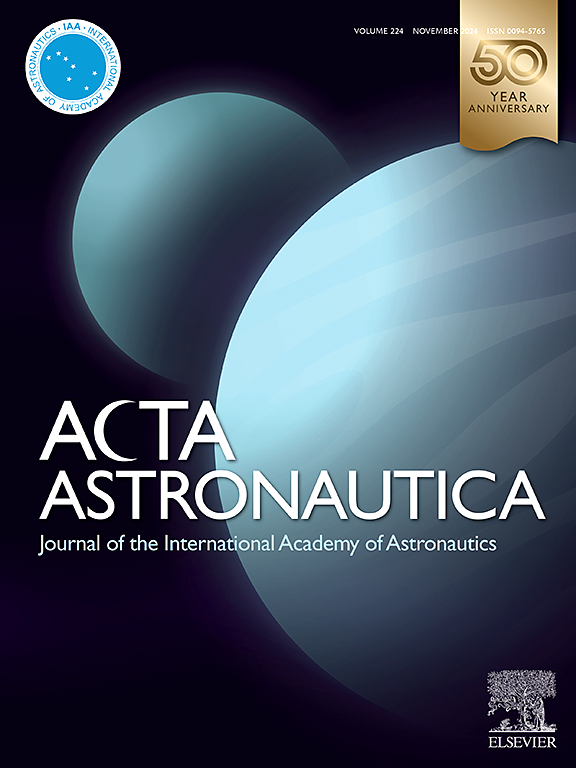冲击载荷作用下机动空间系绳网刚柔耦合动力学与构型稳定性
IF 3.4
2区 物理与天体物理
Q1 ENGINEERING, AEROSPACE
引用次数: 0
摘要
研究了机动空间系绳网在冲击载荷作用下的结构稳定性和刚柔耦合动力学。为了分析网的复杂三维机动,建立了一个几何力学框架,考虑了网中波浪传播与网角上机动卫星姿态动力学之间的刚柔耦合。导出了SO(3)上卫星姿态动力学的无坐标李群表示。利用几何雅可比方法研究了系绳网的平衡状态、模态振型和混沌行为,揭示了系绳网的刚性动力学和卫星缓慢姿态运动共存,导致时间尺度上的极端差异,使传统的积分方案难以进行数值分析。为了解决这一问题,导出了一个保持结构的积分器,以准确地分析网络在长时间内的混沌行为。在两种初始条件下分析了对冲击载荷的动态响应:(i)松弛网和(ii)由卫星控制力和扭矩张紧的网。数值结果表明,网变形与卫星姿态运动之间存在显著的耦合效应,即使是很小的扰动也可能导致网的混沌响应。此外,卫星控制力对网的预张力可以有效地抑制混沌行为,从而获得更稳定的构型和可控的机动。这些研究结果为研究机动空间系绳网的构型稳定性和动力学特性提供了重要见解,将有助于开发有效的控制策略来抑制混沌,提高网在三维空间中的机动性。本文章由计算机程序翻译,如有差异,请以英文原文为准。
Rigid-flexible coupled dynamics and configuration stability of maneuverable space tether net under impact loads
This paper investigates the configuration stability and rigid–flexible coupled dynamics of maneuverable space tether nets under impact loads. To analyze the complex 3D maneuvers of the net, a geometric mechanics framework is developed, incorporating the rigid–flexible coupling between wave propagation in the net and the attitude dynamics of maneuvering satellites attached to its corners. A coordinate-free representation in Lie group is derived for the satellites’ attitude dynamics on . Equilibrium states, modal shapes, and chaotic behavior of the tether net are examined using the geometric Jacobian method, which reveals the coexistence of stiff tether dynamics and slow satellite attitude motions, leading to extreme disparities in time scales and makes numerical analysis challenging by conventional integration schemes. To solve the problem, a structure-preserving integrator is derived to accurately analyze the chaotic behavior of the net over extended periods. Dynamic responses to impact loads are analyzed under two initial conditions: (i) a slack net and (ii) a net tensioned by satellite control forces and torques. Numerical results reveal significant coupling effects between net deformation and satellite attitude motion, and even minor perturbations may lead to chaotic responses of the net indicated by Lyapunov exponents. Moreover, the pre-tension of the net by control forces from satellites can effectively suppress chaotic behaviors, leading to more stable configuration and controlled maneuvering. These findings offer critical insights into configuration stability and dynamics of maneuverable space tether nets, which will enable the effective control strategy development to suppress chaos and enhance net’s maneuverability in three-dimensional space.
求助全文
通过发布文献求助,成功后即可免费获取论文全文。
去求助
来源期刊

Acta Astronautica
工程技术-工程:宇航
CiteScore
7.20
自引率
22.90%
发文量
599
审稿时长
53 days
期刊介绍:
Acta Astronautica is sponsored by the International Academy of Astronautics. Content is based on original contributions in all fields of basic, engineering, life and social space sciences and of space technology related to:
The peaceful scientific exploration of space,
Its exploitation for human welfare and progress,
Conception, design, development and operation of space-borne and Earth-based systems,
In addition to regular issues, the journal publishes selected proceedings of the annual International Astronautical Congress (IAC), transactions of the IAA and special issues on topics of current interest, such as microgravity, space station technology, geostationary orbits, and space economics. Other subject areas include satellite technology, space transportation and communications, space energy, power and propulsion, astrodynamics, extraterrestrial intelligence and Earth observations.
 求助内容:
求助内容: 应助结果提醒方式:
应助结果提醒方式:


